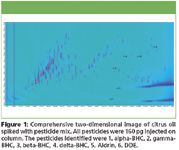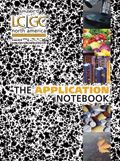Identification of Pesticides in Citrus Oil Using Comprehensive Two Dimensional Gas Chromatography–Mass Spectrometry
Comprehensive two dimensional gas chromatography–mass spectrometry is a powerful method to identify target analytes in complex matrices. An example is shown of identification of pesticides in citrus oil.
Ronald D. Snelling, Shimadzu Scientific Instruments, Inc.
Comprehensive two dimensional gas chromatography–mass spectrometry is a powerful method to identify target analytes in complex matrices. An example is shown of identification of pesticides in citrus oil.
Two dimensional gas chromatography is a technique for improving the resolution of compounds in very complex mixtures. Comprehensive two dimensional chromatography involves passing all analytes through two columns of different selectivities. With proper column choice compounds not separated on the first column are separated on the second column.
A sample of citrus oil was split into two parts, one run neat, and the second spiked with a mixture of pesticides. Both samples were run on a nonpolar-midpolarity column set on a Shimadzu QP-2010Plus single quadrupole GC–MS system. The data collected was processed using GC Image software, used to produce two dimensional images from the original data. Selected ion images were used for pesticide identification.
Experimental Conditions
GC–MS Shimadzu QP-2010 Plus
Thermal modulator ZOEX ZX-2
Column 1: 30 m × 0.25 mm id × 1.0 df DB-1 ms
Column 2: 60 cm × 0.10 mm id × 0.10 df BPX-50
Flow Constant linear velocity mode, 265 kPa initial pressure
Injection 1 μL split 25:1
Temperature program 40 °C, 4 min, 5 °C/min to 100 °C, 1 °C/min to 200 °C, 2 °C/min to 300 °C, 5 min
Scan Range 45 to 290 amu, 30 scans/s
Results
Figure 1 is an image of the two dimensional chromatogram, with retention time on the long nonpolar column on the X-axis and retention time on the short midpolarity column on the Y-axis. Peak height is represented as color, with blue being lowest intensity and yellow highest intensity.

Figure 1
Most citrus oil compounds eluted earlier than the pesticides on the first column, but there are still a significant number of compounds in the citrus oil that elute during the pesticide elution time. Using the library search functions in GC Image it is possible to identify components of the citrus oil and the spiked pesticides, for example the peak labeled L in Figure 1 is limonene.
The six peaks labeled 1 through 6 in the image are pesticides spiked into the citrus oil, with all pesticides having a mass of 160 pg injected onto the column. The pesticides are all resolved from the other compounds in the two dimensional image even though they may not be resolved from matrix components in the first column. For example, delta-BHC, number 4 on the image, coelutes with at least three other compounds on the first column, but is resolved from them in the second column.
Conclusion
Comprehensive two dimensional gas chromatography is a powerful tool for identification of trace components in a complex matrix.

Shimadzu Scientific Instruments, Inc.
7102 Riverwood Drive, Columbia, MD 21046
tel. (410)381-1227; fax (410)381-9531
Website: www.ssi.shimadzu.com

Analysis of Pesticides in Foods Using GC–MS/MS: An Interview with José Fernando Huertas-Pérez
December 16th 2024In this LCGC International interview with José Fernando Huertas-Pérez who is a specialist in chemical contaminants analytics and mitigation at the Nestlé Institute for Food Safety and Analytical Sciences at Nestlé Research in Switzerland, In this interview we discuss his recent research work published in Food Chemistry on the subject of a method for quantifying multi-residue pesticides in food matrices using gas chromatography–tandem mass spectrometry (GC–MS/MS) (1).
















